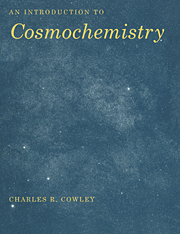Book contents
- Frontmatter
- Contents
- Foreword
- 1 Overview
- 2 Minerals: An Introduction to the Nomenclature and Chemistry
- 3 A Brief Introduction to Petrology
- 4 A Résumé of Thermodynamics and Statistical Mechanics
- 5 Condensation Sequences and the Geochemical Classification of the Elements
- 6 The Theory of the Bulk Composition of the Planets
- 7 Meteorites and the Standard Abundance Distribution (SAD)
- 8 An Introduction to Isotope Geology with an Emphasis on Meteorites
- 9 Some Concepts from Nuclear Physics
- 10 Energy Generation in Stars and Nucleosynthesis
- 11 Atomic and Molecular Spectra
- 12 The Analysis of Stellar Spectra
- 13 The Chemistry of Stars and Stellar Systems
- 14 Cold, Non-stellar Material in Galaxies
- 15 Emission-Line Regions and their Chemical Abundances
- 16 Abundances of the Elements in Galaxies
- Appendix
- References
- Index
13 - The Chemistry of Stars and Stellar Systems
Published online by Cambridge University Press: 05 June 2012
- Frontmatter
- Contents
- Foreword
- 1 Overview
- 2 Minerals: An Introduction to the Nomenclature and Chemistry
- 3 A Brief Introduction to Petrology
- 4 A Résumé of Thermodynamics and Statistical Mechanics
- 5 Condensation Sequences and the Geochemical Classification of the Elements
- 6 The Theory of the Bulk Composition of the Planets
- 7 Meteorites and the Standard Abundance Distribution (SAD)
- 8 An Introduction to Isotope Geology with an Emphasis on Meteorites
- 9 Some Concepts from Nuclear Physics
- 10 Energy Generation in Stars and Nucleosynthesis
- 11 Atomic and Molecular Spectra
- 12 The Analysis of Stellar Spectra
- 13 The Chemistry of Stars and Stellar Systems
- 14 Cold, Non-stellar Material in Galaxies
- 15 Emission-Line Regions and their Chemical Abundances
- 16 Abundances of the Elements in Galaxies
- Appendix
- References
- Index
Summary
The General Framework
In this chapter we consider the results of the analytical methods discussed in Chapter 11 insofar as they apply to stars, and to the integrated starlight of some star clusters. Many of these results were obtained with methods that are directly applicable to the analysis of extragalactic systems. We shall postpone a general discussion of the chemical evolution of our own and external galaxies until Chapter 16.
The main pillars of any description of stars and stellar systems are spectral classification, and the Hertzsprung–Russell (H–R) diagram or some variation of it. Classification itself provides mostly information about the temperatures and pressures in the photospheres of stars. Since the majority of stars have rather similar compositions, classification mainly discriminates between the broad categories of normal and peculiar chemistry. The chemically peculiar stars are in many ways the most interesting. The position of a star on the Hertzsprung–Russell diagram (§13.3) indicates its state of evolution. Usually, this tells us something of the chemistry of the star's interior, but occasionally, what has happened in the interior of a star is manifested on its surface. Only a very brief summary of these concepts can be given here.
Most stars belong to double or multiple systems. Double stars were discovered by Sir William Herschel in the late eighteenth century, and a century later, their study was well developed. The marvelous Father Angelo Secchi (1878, p. 228) suggested that perhaps half of the visible stars had physically bound companions.
- Type
- Chapter
- Information
- An Introduction to Cosmochemistry , pp. 289 - 314Publisher: Cambridge University PressPrint publication year: 1995

